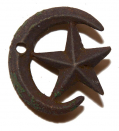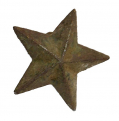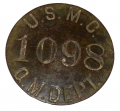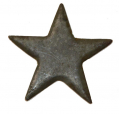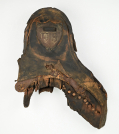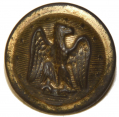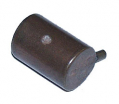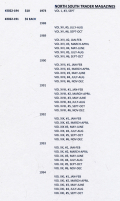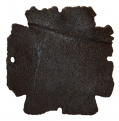site search
online catalog
Relics
Showing 301 to 350 out of 353
RELIC .36 CALIBER BRASS TWO-CAVITY BULLET MOLD – RECOVERED NEAR FREDERICSBURG
This is an excavated .36 caliber two cavity bullet mold for “Navy” revolvers. The mold halves are brass with a steel sprue cutter, screw, and pins. The mold is approximately 5” in overall… (2022-1313). Learn More »
POST CIVIL WAR VIRGINIA TWO-PIECE SWORD BELT BUCKLE
This sword belt plate is very similar to some wartime and prewar Virginia plates, but we feel it probably postdates the war, though excavated in Orange, Virginia. The central disk with narrow edge… (1184-117). Learn More »
RELIC BRASS STAR & CRESCENT CAPE PIN EXCAVATED AT ROULETTE FARM, ANTIETAM
Excavated brass cape pin. Although not actually a “pin,” a thin chain connected two such pieces and was run through button holes to hold a cape closed. These are found in various shapes including… (490-3794). Learn More »
RELIC BRASS STAR & CRESCENT-SHAPED CAPE PIN & CHAIN EXCAVATED NEAR FREDERICKSBURG
Excavated brass cape pin and chain. Although not actually a “pin,” a chain connected two such pieces and was run through button holes to hold a cape closed. These are found in various shapes… (2022-1349). Learn More »
RELIC BRASS STAR-SHAPED CAPE PIN EXCAVATED NEAR FREDERICKSBURG
Excavated brass cape pin. Although not actually a “pin,” a thin chain connected two such pieces and was run through button holes to hold a cape closed. These are found in various shapes including… (2022-1394). Learn More »
RELIC CIVIL WAR PICKET PIN – RECOVERED NEAR FREDERICKSBURG
This is an excavated Civil War iron picket pin. A regulation piece of equipment for cavalrymen. Used to stake-down a horse temporarily while on picket or grazing. Measures 11 ½” long overall.… (2022-1391). Learn More »
RELIC WW1-ERA USMC QM DEPARTMENT BADGE
This is an excavated badge from an employee at the U.S.M.C. quartermaster department. The brass badge is engraved “U.S.M.C. / 1098 / Q.M. DEPT.” and has an even “dug” green patina. There is a… (2022-1369). Learn More »
RELIC “STAR” DEVICE RECOVERED NEAR FREDERICKSBURG
This is an excavated brass star. The piece has a smooth chocolate-brown patina overall. Measures 35mm across. A small central hole on the back side is the only indication of where an attachment device… (2022-1346). Learn More »
SECTION OF M1863 MUSKET WITH BLOWN BARREL FOUND IN PENNSYLVANIA CAVE
Offered here is the rear portion of a Model 1863 rifle musket, with severe damage, that was reportedly found in a Western Pennsylvania cave by arrowhead hunters. The rifle musket looks to have been… (991-25). Learn More »
RARE CONFEDERATE TINNED IRON CLIP-POINT BOWIE KNIFE SCABBARD BY BOYLE AND GAMBLE, FROM THE MOLLUS WAR LIBRARY AND MUSEUM, FROM THE BATTLE OF CAMP BARTOW, W. VIRGINIA
This extremely rare tinned iron scabbard is for a clip-point Bowie knife and is slightly shorter, but a match for the scabbard on a rare Virginia D-guard Bowie made and marked by Boyle and Gamble,… (1052-17). Learn More »
US RELIC MODEL 1842 MUSKET LOCK PLATE
Lock is heavily rusted throughout. Most of the internal parts are present. It appears that only the tumbler and sear spring are missing. Hammer is frozen in place. Hammer screw is also… (1000-2146). Learn More »
CANTLE OF A GRIMSLEY PATTERN ARTILLERY DRIVER’S SADDLE FROM CITY POINT
Located at the confluence of the Appomattox and James Rivers, City Point was the site of Grant’s headquarters in the Petersburg campaign and also a massive supply depot and transportation hub with… (2022-467). Learn More »
SOUVENIR LETTER OPENER MADE FROM LOOKOUT MOUNTAIN WOOD WITH STANHOPE LENS
Offered here is a souvenir letter opener made from a small branch or sapling. Grip portion is untouched with original bark. The end of the grip is cut on a 45-degree angle and has a Stanhope lens… (2022-611). Learn More »
RARE CONFEDERATE “THREE SQUARE” SOCKET BAYONET
This is an excavated example of a Confederate-made musket socket bayonet. Measuring 21” overall with a 2.75” socket. This was made for an early .69 caliber musket with a bayonet lug mounted on… (2022-459). Learn More »
CONFEDERATE LOCAL ARMY OFFICER’S COAT BUTTON
CS42A; BM: blank with a depressed channel. 22mm. Excavated with very nice patina with lots of gilt. Shank has been glued in place. Slight push on front. [ss]… (766-1464). Learn More »
$1,600.00
Originally $2,000.00
1816 STYLE US BAYONET SCABBARD THROAT
Scabbard throat has maker’s mark, “R. DINGEE, N- YORK”. Found in a CS camp in Fredericksburg, VA. [sl] [ph:L] ~~~~~~~~~~~~~~~~~~~~~~~~~~~~~~~~~~~ THIS ITEM, AS WITH ALL OTHER ITEMS AVAILABLE ON… (R21367). Learn More »
$65.00
Originally $75.00
COLORED CLAY MARBLES - FREDERICKSBURG, VA
Recovered from US camp site used by Rhode Island troops. [ph:L] ~~~~~~~~~~~~~~~~~~~~~~~~~~~~~~~~~~~ THIS ITEM, AS WITH ALL OTHER ITEMS AVAILABLE ON OUR WEB SITE, MAY BE PURCHASED THROUGH OUR… (R13847). Learn More »
$20.00 Each
Originally $25.00
9MM FRENCH PINFIRE BLANK CARTRIDGE
In very good condition. [ph:L] ~~~~~~~~~~~~~~~~~~~~~~~~~~~~~~~~~~~ THIS ITEM, AS WITH ALL OTHER ITEMS AVAILABLE ON OUR WEB SITE, MAY BE PURCHASED THROUGH OUR LAYAWAY PROGRAM. CLICK HERE FOR OUR… (R17072). Learn More »
$15.00
Originally $20.00
RELICS FOUND ON KENNESAW MOUNTAIN, GA
One barrel band, one canister ball, one musket wrench, one musket hammer, and one percussion cap found at Kennesaw Mountain. Tag is in fair condition and reads "_on Kenesaw Moutai_." All items in… (R17421). Learn More »
$175.00
Originally $250.00
SELECTION OF NORTH SOUTH TRADER'S CIVIL WAR MAGAZINES
Available is a selection from a recently acquired collection of North South Trader's Civil War magazines. One issue from 1973 is $10.00; the remaining issues are $5.00 each. Included are scans of…. Learn More »
COPPER SABOT FROM 3” MULLANE SHELL FROM GETTYSBURG
Found in Gettysburg after the battle. From the Soldier’s National Museum auction of 2014. Copper sabot stripped from a Confederate 3” Mullane artillery shell. The sabot is a round disk with a… (224-514). Learn More »
RELIC CONDITION M1816 BAYONET
This relic condition bayonet was made for the US Model 1816 Flintlock Musket longarm. In time, the M1816 was converted to a percussion musket and the accompanying accoutrements could also be affixed… (179-1119). Learn More »
RARE 10” MORTAR SHELL (FRENCH & INDIAN OR REVOLUTIONARY WAR) FROM FORT TICONDEROGA MUSEUM COLLECTION
This early mortar shell was once housed in the Fort Ticonderoga Museum collection. It is an excavated 10” mortar shell in relic condition. The iron body of the shell is in solid condition with… (1117-26). Learn More »
RELIC 5TH CORPS BADGE DUG AT PETERSBURG
Sheet iron 5th Corps badge that meas. approx. 1.25 x 1.25 inches. There is a faint crease in the left half of the badge and each arm has lost a small bit of iron giving the cross a truncated… (1132-02). Learn More »
RELIC M1873 MAYNARD BULLET MOLD
Iron bullet mold measures approximately 7 ½” long. Two halves pinned with rivet and has floating sprue cutter. Iron is pitted but not badly; could be “dug” or out of a barn. Still opens and… (1117-238). Learn More »
EARLY 19TH CENTURY HORSE BIT
Shows some rust but generally in fine condition. ~~~~~~~~~~~~~~~~~~~~~~~~~~~~~~~~~~~ THIS ITEM, AS WITH ALL OTHER ITEMS AVAILABLE ON OUR WEB SITE, MAY BE PURCHASED THROUGH OUR LAYAWAY PROGRAM. FOR… (M19080). Learn More »
$95.00
Originally $137.50
ON HOLD
RELIC MODEL 1841 MISSISSIPPI BARREL
Barrel meas. approx. 30.00 inches from muzzle to the tip of the breech tang. Item is rusted throughout. Most of the front sight remains. There is no rear sight and nipple is broken off. No markings… (1000-2589). Learn More »
RELIC CONFEDERATE RICHMOND CARBINE BARREL WITH MODEL 1855 SIGHT
Barrel meas. approx. 25.00 inches long. The front sight is present at the muzzle and the rear sight at the breech. Rear sight retains both flip-up leaves which are now frozen. Bolster with clean out… (1000-2586). Learn More »
RELIC MODEL 1842 SPRINGFIELD LOCKPLATE
Excavated iron lockplate from Springfield musket. Surface pitting from being in the ground but has been lightly cleaned and coated. Lockplate only. [jet] ~~~~~~~~~~~~~~~~~~~~~~~~~~~~~~~~~~~ THIS… (1000-2122). Learn More »
RELIC MODEL 1816 SPRINGFIELD LOCKPLATE
Excavated iron lockplate from Springfield musket. Surface pitting from being in the ground but has been cleaned by electrolysis. Most of “SPRING / FIELD / 1834” and “US” is visible amid… (1000-2125). Learn More »
$40.00
SOLD
RELIC MODEL 1816 SPRINGFIELD LOCKPLATE
Excavated iron lockplate from a m-1816 Springfield musket that was converted to percussion. Surface pitting from being in the ground but has been cleaned by electrolysis. “US” is visible amid… (1000-2128). Learn More »
RELIC MODEL 1855 LOCKPLATE AND HAMMER
Excavated iron lockplate from a Model 1855 rifle musket. Lockplate with hammer and components. Hump back style plate featuring cutout for Maynard’s primers. Relic is encrusted with rust and has… (1000-2115). Learn More »
DUG CONFEDERATE SPUR
This is a nice, excavated Confederate spur. It is cast brass and retains a good green patina. Possibly a copy of a civilian style. Has curved neck with no iron rowel remaining. Slight bend at… (1000-1520). Learn More »
DUG CONFEDERATE SPUR
This is a nice, excavated Confederate spur. Similar in style to federal spurs. It is cast brass and retains a good green patina. Has squared-off neck with no iron rowel remaining. Slight bend in… (1000-1515). Learn More »
CONFEDERATE .69 SOCKET BAYONET MADE INTO POT/BODY HOOK
Bayonet has a blade section that is made of one solid piece of triangular shaped iron. All three surfaces of the blade are smooth and minus any fullers. Blade section has a broken tip and has been… (1000-742). Learn More »
RARE CONFEDERATE “THREE SQUARE” SOCKET BAYONET
This is an excavated example of a Confederate-made musket socket bayonet, probably for a M-1816 musket. Measuring 20” overall with a 2 5/8” socket. This was made for an early .69 caliber… (1000-1385). Learn More »
MODEL 1816 BAYONET ALTERED INTO A HOE OR DIGGING TOOL
This item consists of a 3.00 inch long socket with a generally “T”-shaped lug mortise. Knuckle was straightened and only 5.50 inches of the blade remains. When the blade was cut down the end was… (1000-1369). Learn More »
SHIPWRECK RECOVERED STATE OF NEW YORK BUCKLE
This relic is an “SNY” (State of New York) buckle. Only the lead remains, the brass face and iron belt hooks deteriorated in the ocean long ago. This is an excellent example from this wreck site… (883-33). Learn More »
$300.00
Originally $400.00
2nd CORPS BADGE IN RELIC CONDITION
Iron 2nd corps badge has light surface rust. Reverse originally featured a soldered attachment pin with hook, but all that is present is the base of both. Corps badges were attached to the soldier’s… (883-58). Learn More »
$425.00
Originally $495.00
DUG 3rd CORPS BADGE
Brass 3rd corps badge has a darkened patina. Two small holes are present which were for sewing to the soldier’s hat or left side of the uniform. This avoided confusion on the battlefield as a… (883-47). Learn More »
$395.00
Originally $450.00
RELIC 5th CORPS BADGE
Brass 5th corps badge has a darkened patina. Reverse originally featured a soldered attachment pin with hook, but all that is present is the base of both. Also present are two holes on the sides which… (883-64). Learn More »
$395.00
Originally $500.00
DUG PORTION OF 7TH CORPS BADGE
Brass 7th corps badge has a darkened patina; missing the 5 pointed star that should be in the center opening of the “C”. Corps badges were attached to the soldier’s hat or left side of the… (883-21). Learn More »
$250.00
Originally $295.00
RELIC AUSTRIAN CLEANING JAG
This is an excavated appendage for a rifle. This is an Austrian cleaning jag. In use this was attached onto the threaded end of the ramrod and used with a rag to clean the barrel. This is for a .54… (883-344). Learn More »
RELIC U.S. EAGLE NCO BALDRIC PLATE
This excavated U.S. plate for the NCO baldric features the spread-winged eagle design. Plate has great detail on the face and a dark brown patina. Edge of plate is free of nicks. Reverse of plate… (883-11). Learn More »
$395.00
SOLD
DUG SILVER 18TH CORPS ID BADGE FOR 98TH NEW YORK SOLDIER WOUNDED IN ACTION
Silver 18th Corps badge identified to Private Joseph Laclair of Company H, 98th New York Infantry, recovered in the greater Richmond area. Badge meas. approx. 1.75 x 1.75 inches. In both the upper and… (883-20). Learn More »
GOOD CONDITION RELIC FLEEM
This double-bladed fleam is still housed in its brass casing but the blades are rusted in place. The brass case has a nice green patina. Area of recovery is not… (408-196). Learn More »
EXCAVATED FEDERAL ENGINEER’S BUTTON, EG6
Two part low convex coat button. Button depicts eagle with banner with motto, "Essayons", fortifications, and rising sun, intended for officers of the engineer corps. Backmark no longer… (127-1604). Learn More »
IRON CASE-SHOT BALL FROM GETTYSBURG
Rusted condition iron case-shot ball. Items are from the Rosensteel family collection of Gettysburg artifacts. Selection is our choice. We will send the best one available. PLEASE DO NOT REQUEST A… (173-1267). Learn More »
SECTION OF MUSICAL INSTRUMENT FROM SPOTSYLVANIA – GAVIN COLLECTION
Fluted brass section that meas. approx. 3.00 inches long on one end and tapers to 0.75 of an inch on the other. The item appears to be the bell of some kind of horn. The piece has been flattened by… (601-857). Learn More »
RELIC 5TH CORPS BADGE
Made of iron, with original stick pin saudered on reverse. Measures 1and 5/16” per side. Exhibits dark patina with pitting & scuffing on obverse. Else vg, & solid. Location of recovery… (713-15). Learn More »
Showing 301 to 350 out of 353
Most Popular
Historical Firearms Stolen From The National Civil War Museum In Harrisburg, Pa »
Theft From Gravesite Of Gen. John Reynolds »
Selection Of Unframed Prints By Don Troiani »
Fine Condition Brass Infantry Bugle Insignia »
British Imported, Confederate Used Bayonet »
Scarce New Model 1865 Sharps Still In Percussion Near Factory New »
featured item
28th NEW JERSEY PAINTED REGIMENTAL EAGLE DRUM IDENTIFIED TO DRUMMER AARON BUZZEE, COMPANY K: FREDERICKSBURG AND CHANCELLORSVILLE!
This Civil War regimental eagle drum has a totally original painted designation to the 28th New Jersey and drummer Aaron Buzzee of Company K. The regiment enlisted for just nine months service in Fall 1862, but found itself in two momentous battles:… (766-1858). Learn More »





